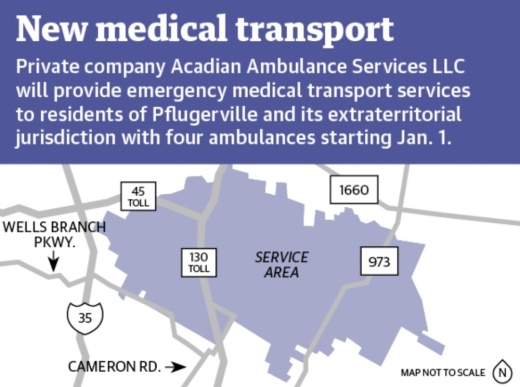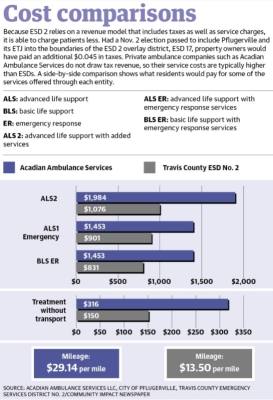The decision comes largely due to a request from Travis County Emergency Services District No. 2 officials for the city to provide a $2.8 million subsidy—an amount the ESD stated is necessary to continue providing EMS and ambulance services.
Officials from ESD 2 and the city have disputed over the issue for several months, from the official subsidy request in January to City Council’s hiring of Acadian Ambulance Services LLC on Nov. 9.
But now that the two-year contract with Acadian is official and begins Jan. 1, parties on both sides of the issue have stated it is crucial to come together to clarify expectations for emergency transport in Pflugerville and its extraterritorial jurisdiction, or ETJ.
“One of my key priorities, of course, has always been public health and safety, and this is a very hot topic,” said Kimberly Holiday, who was elected to Pflugerville City Council on Nov. 2. “My question has always been the same: ‘If I dial 911, who’s coming; how long will it take them to get there; and will they be able to help me?’”
A brief history
ESD 2, which is also commonly referred to as the Pflugerville Fire Department, provides fire and rescue, EMS and advanced life support, or ALS, services to Pflugerville, the city’s extraterritorial jurisdiction, parts of the city of Austin and unincorporated Travis County.
On May 1, residents in parts of Austin and unincorporated Travis County voted to add an overlay district called ESD 17 within the ESD 2 boundaries.
Pflugerville City Council opted out of that election, but because voters outside the city and in its ETJ approved the creation of the new overlay district, ESD 17 was then legally allowed to initiate an election to annex the city into its taxing and service boundaries, according to Texas election law.
On Nov. 2, residents voted not to be a part of ESD 17 by about 62% against to around 38% for.
Amid the push to annex the city and its ETJ, Pflugerville City Council was already months into its own strategy to move on from ALS and emergency services provided by ESD 2.
In February, City Council commissioned a study seeking to find out if the $2.8 million subsidy request from ESD 2 to facilitate costs for staff, equipment and capital expenses for emergency medical response was valid.
AP Triton, a consulting firm specializing in service delivery methodology and practices for fire and emergency care services, delivered its findings in June. The results stated ESD 2 does not need the $2.8 million annual subsidy to stay solvent.
Among other modifications, ESD 2 could solve many of its financial concerns through a more efficient billing system, the report stated.
Expectations for the new system
Citing the AP Triton report, Pflugerville City Council Member David Rogers said historically 46% of ALS and ambulance calls through ESD 2 have serviced people outside the city.
“Effectively, what that means is that there have been two and a half ambulances for the city of Pflugerville,” Rogers said.
The city’s contract with Acadian stipulates the company will start with four ambulance units placed at strategic substations within its operational boundaries that include the city and its ETJ.
Acadian will also provide more ambulance units as the service area’s population and needs grow, said Butch Oberoff, director of governmental relations and business development for Acadian.
However, ESD 2 officials, Travis County officials and some residents have repeatedly brought up the cost and bill collection methods they say are associated with private ambulance services.
In an Oct. 30 statement to Pflugerville City Council, ESD 2 Chief Nicholas Perkins condemned for-profit ambulance companies.
“The for-profit ambulance business model is built upon underperformance because there is no community investment,” Perkins said in the statement. “The for-profit company will gladly pay violation fines to the city to underperform as a cost of doing business.”
Oberoff said Acadian works in-network with about 75% of the health plans in Texas—a figure that is comparable with most other EMS agencies.
For those who are uninsured or having trouble paying Acadian, he said, the company offers opportunities for debt forgiveness. He estimates Acadian, which mainly operates in Louisiana and Texas, forgives about $60,000 in debt per year companywide.
Working toward balance
Rogers said come Jan. 1, he expects 911 calls for medical emergencies to be routed to both ESD 2 and to Acadian.
“If the ESD gets there first with their fire trucks and they provide basic life support, which they said they were going to do, they can do that, and then the Acadian guys will get there and they can proceed and provide advanced life support,” Rogers said.
Perkins said the situation is more complicated, especially since the city enacted a franchise requirement mandating ambulance providers to contract with the city before providing services.
What makes Pflugerville’s franchise requirement unique is a stipulation highlighting first response, he said.
“Very few, if any, EMS agencies provide first response,” he said. “That is overwhelmingly provided by fire departments.”
Perkins said Pflugerville Mayor Victor Gonzales sent his department a letter Nov. 12 expressing a need to meet and solidify expectations for emergency response calls.
Holiday said she agrees it is crucial to establish firm expectations.
“That means we need to start talking now,” Holiday said. “When we get right down to it, the bottom line is, will the people of Pflugerville be taken care of?”






